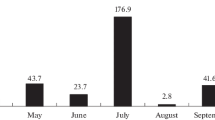Abstract
The results of research of diurnal and seasonal dynamics of CO2 emission from the oligotrophic swamp surface in the southern taiga subzone of Western Siberia in 2005–2007 are under consideration. During the summertime, the intensity of CO2 emission increases from spring to the midsummer and then decreases by the fall. A mean CO2 emission value was 118 mg CO2/(m2 hour). The analysis of diurnal dynamics of CO2 emission showed that the maximum CO2 flux is observed at 16:00, while the minimum, at 07:00. Mean amplitude of diurnal variations of the CO2 emission is 74 mg CO2/(m2 hour). The relations established between air temperature and CO2 flux allowed calculating carbon dioxide emission for the periods between measurements. It was found that in the summertime, the period between 10:00 and 13:00 was optimal for measuring CO2 emission with a chamber method.
Similar content being viewed by others
References
Big Vasyugan Swamp. Current State and Development Processes, Ed. by M. V. Kabanov (IOA SO RAN, Tomsk, 2002) [in Russian].
S. E. Vomperskii, “The Role of Swamps in Carbon Cycle,” in Biogeocenosis Peculiarities of Swamps and Their Rational Use (Nauka, Moscow, 1994) [in Russian].
E. A. Golovatskaya and E. V. Porokhina, Botany and Phytocenology Principles: Biological Productivity of Swamp Biogeocenoses (Guidance Manual) (TGPU, Tomsk, 2005) [in Russian].
E. A. Dyukarev, E. A. Golovatskaya, A. D. Duchkov, and S. A. Kazantsev, “Experimental Research of Heat Regime of a Peat Deposit,” Geologiya i Geofizika, No. 6 (2009) [Geology and Geophysics, No. 6 (2009)].
E. A. Dyukarev, E. A. Golovatskaya, I. I. Ippolitov, and M. V. Kabanov, “Influence of Landscape and Hydrometeorological Conditions on CO2 Emission in Peat Bog Ecosystems,” Dokl. Ros. Akad. Nauk, No. 4 (2008) [Dokl. Russ. Acad. Sci., No. 4 (2008)].
S. P. Efremov and T. T. Efremova, “Experimental Diagnosis of Peat Accumulation and Organic Matter Transformation in Forest-Bog Ecosystems of Western Siberia,” in Peatlands in Western Siberia and Carbon Cycle: Past and Present. Proceedings of the Second International Field Symposium, August 24–September 2, 2007, Khanty-Mansisk, Ed. by S. E. Vomperskii (NTL, Tomsk, 2007).
M. V. Kabanov, “Regional Aspects of Modern Climatology from the Results of the Analysis of Natural Climatic Changes Observed in Siberia,” Optika Atmos. Okeana, No. 11, 19 (2006) [Atmos. Oceanic Optics, No. 11, 19 (2006)].
I. L. Kalyuzhnyi and S. A. Lavrov, “Influence of Hydrological Regime on Carbon Dioxide Fluxes over Oligotrophic Bog Massif in Northwestern Russia,” Meteorol. Gidrol., No. 6 (2007) [Russ. Meteorol. Hydrol., No. 6, 32 (2007)].
D. V. Karelin and D. G. Zamolodchikov, Carbon Exchange in Cryogenic Ecosystems (Nauka, Moscow, 2008) [in Russian].
V. N. Kudeyarov and I. N. Kurganova, “Russian Soil Respiration: Database Analysis, Long-term Monitoring, General Estimates,” Pochvovedenie, No. 9 (2005) [Soil Science, No. 9 (2005)].
I. N. Kurganova and V. N. Kudeyarov, “Assessment of Carbon Dioxide Fluxes from Soils in the Russian Taiga Zone,” Pochvovedenie, No. 9 (1998) [Soil Science, No. 9 (1998)].
IPCC 2007. Climate Change 2007. Synthesis Report. WG I, II, and III Contribution to the Fourth Assessment Report of the Intergovernmental Panel on Climate Change (IPCC, Geneva, 2007).
A. V. Naumov, “Seasonal Dynamics and Intensity of CO2 Release in Siberian Soils,” Pochvovedenie, No. 12 (1994) [Soil Science, No. 12 (1994)].
Carbon Pools and Fluxes in Russian Terrestrial Ecosystems, Ed. by G. A. Zavarzin (Nauka, Moscow, 2007) [in Russian].
M. Aurela, T. Laurila, and J.-P. Tuovinen, “Seasonal CO2 Balances of a Subarctic Mire,” J. Geophys. Res., No. D2, 106 (2001).
M. S. Botch, K. I. Kobak, T. S. Vinson, and T. P. Kolchugina, “Carbon Pools and Accumulation in Peatlands of the Former Soviet Union,” Global Biogeochemical Cycles, No. 1, 9 (1995).
J. L. Bubier, P. M. Crill, and A. Mosedale, “Peatland Responses to Varying Interannual Moisture Conditions as Measured by Automatic CO2 Chambers,” Global Biogeochemical Cycles, No. 2, 17 (2003).
E. Gorham, “Northern Peatlands: Role in Carbon Cycle and Probable Responses to Climatic Warming,” Ecological Applications, No. 2, 1 (1991).
J. E. P. Heikkinen, T. Virtanen, J. T. Huttunen, et al., “Carbon Balance in East European Tundra,” Global Biogeochemical Cycles, 18 (2004).
P. M. Lafleur, T. R. Moore, N. T. Roulet, and S. Frolking, “Ecosystem Respiration in a Cool Temperature Bog Depends on Peat Temperature but Not Water Table,” Ecosystems, 8 (2005).
D. K. McDermit, L. Xu, R. Madsent, et al., “Feedback of Ambient Air CO2 Concentration on Soil CO2 Efflux,” Geophys. Res. Abstracts, 9 (2007).
A. V. Naumov, “Carbon Budget and Emission of Greenhouse Gases in Bog Ecosystems of Western Siberia,” Eurasian Soil Science, 37 (2004).
Y. Sheng, L. C. Smith, G. M. MacDonald, et al., “A High-resolution GIS-based Inventory of the West Siberian Peat Carbon Pool,” Global Biogeochemical Cycles, 18 (2004).
Author information
Authors and Affiliations
Additional information
Original Russian Text © E.A. Golovatskaya, E.A. Dyukarev, 2011, published in Meteorologiya i Gidrologiya, 2011, No. 6, pp. 84–93.
About this article
Cite this article
Golovatskaya, E.A., Dyukarev, E.A. Seasonal and diurnal dynamics of CO2 emission from oligotrophic peat soil surface. Russ. Meteorol. Hydrol. 36, 413–419 (2011). https://doi.org/10.3103/S1068373911060094
Received:
Published:
Issue Date:
DOI: https://doi.org/10.3103/S1068373911060094




